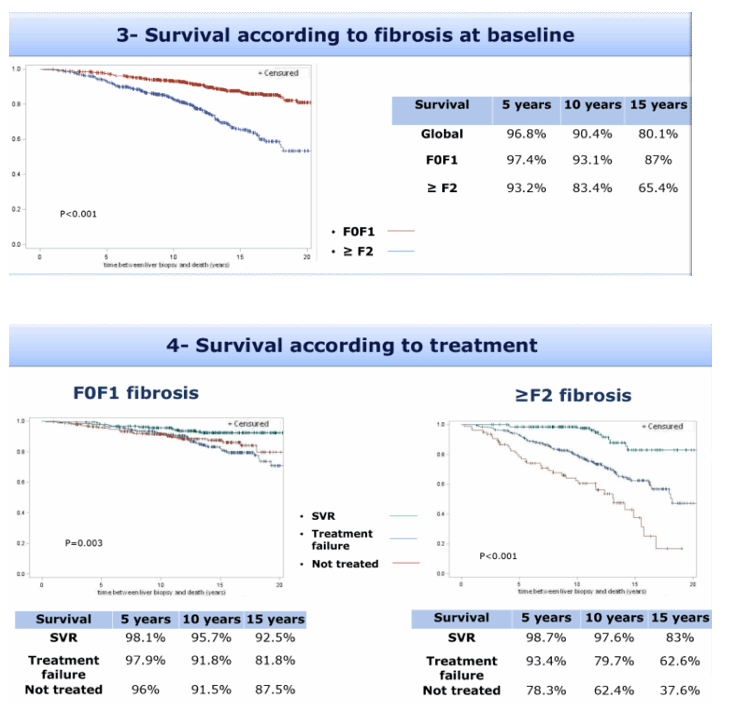 |
 |
 |
| |
SURVIVAL OF PATIENTS INFECTED BY CHRONIC HEPATITIS C AND F0F1 FIBROSIS AT BASELINE AFTER A 15 YEARS FOLLOW-UP
|
| |
| |
Reported by Jules Levin
EASL April 2015 Vienna, Austria

Program Abstract:
Background
The cost of direct antivirals for the treatment of chronic viral hepatitis C (CHC) is currently very high. In France, antiviral agents are restricted to patients with significant fibrosis (≥ F2) and patients with F0F1 fibrosis are excluded. However long-term follow-up and survival of these patients without significant fibrosis is not well described.
Methods
Patients were selected from a single-center cohort of 4293 consecutive CHC patients included since 1992. Inclusion criteria were HCV-RNA positivity and liver fibrosis evaluated by biopsy at baseline. Survival was obtained from death certificate. Two groups were compared according to baseline fibrosis: F0F1 versus ≥ F2.
Results
1381 patients were included (60% male, 52.4% G1 and 19.4% G3, 38.8% drug users). At baseline median age was 43 years [36-53], stage of fibrosis: F0F1 59.4%, F2 18.5%, F3 9.5% and F4 12.6%. Compared to F2, F0F1 patients were younger (42 ± 12 vs 50 ± 13 years,p<10-3), had lower prevalence of male (57% vs 64.5%, p=0.005) and antiviral treatment (68.8% vs 86.1%, p<10-3) and a higher prevalence of sustained virological response (SVR: 48% vs 34.9%, p<10-3). After a median follow-up of 4.6 [2.9-7.7] years, a 2nd liver biopsy was performed in 157 patients F0F1 (19.1%), 50 patients F2 (19.5%) and 28 patients F3 (21.4%). An increased fibrosis stage to F3 or F4 was observed in 15.3% of F0F1 patients, 48% of F2 patients and 46.7% in F3 patients (to F4). After a median follow-up of 11.9 years [8.7-15.5], 248 patients died (16.7%), more frequently in ≥ F2 patients (24.4%) than in F0F1 patients (11.5%), p<10-3. Median survival at 5, 10 and 15 years after the first liver biopsy was 97.4%, 93.1% and 87% in patients F0F1 and 93.2%, 83.4% and 65.4% in F≥2 patients. Survival was better in treated patient with SVR than in untreated patient or treated without SVR regardless fibrosis stage, as shown in figure below.
Conclusion
Antiviral treatment for F0F1 patients at baseline should be considered due to (i) an evolution to severe fibrosis in at least 15%, (ii) a better response to treatment (SVR achieved in 48%), (iii) an improved survival in patients with SVR compared to those without SVR demonstrated in both F0F1 and F≥2 groups.



|
| |
|
 |
 |
|
|